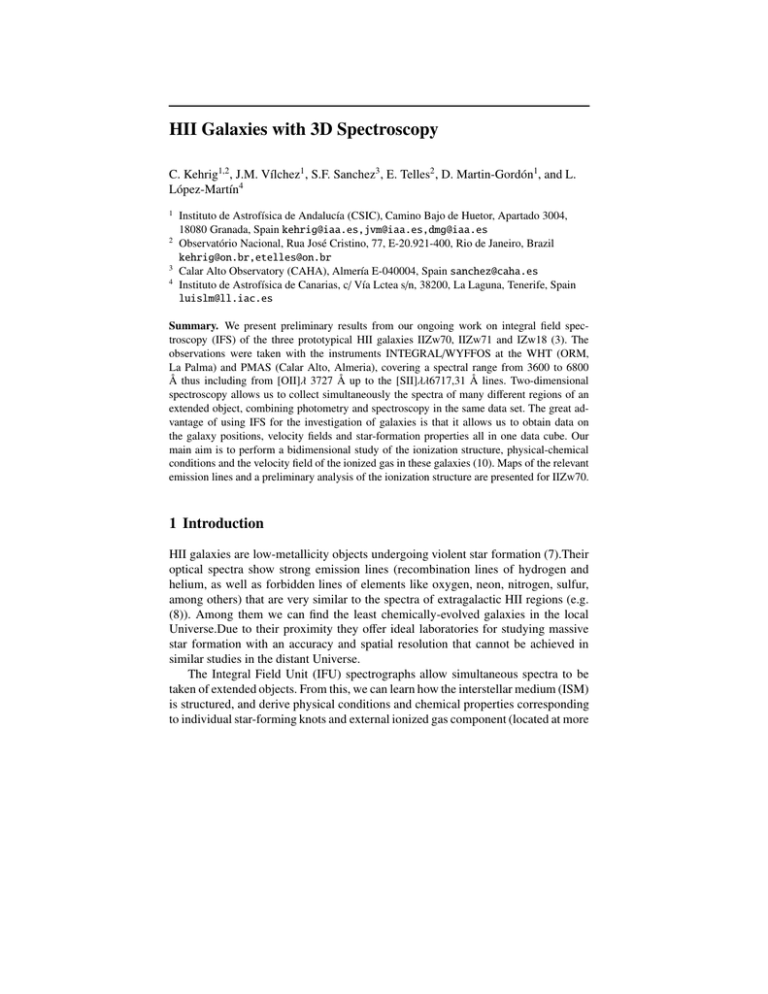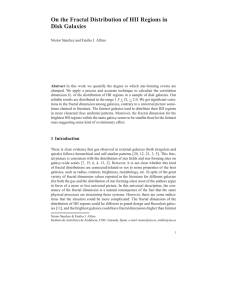HII Galaxies with 3D Spectroscopy C. Kehrig , J.M. V´ılchez , S.F. Sanchez
advertisement

HII Galaxies with 3D Spectroscopy C. Kehrig1,2, J.M. Vı́lchez1 , S.F. Sanchez3 , E. Telles2 , D. Martin-Gordón1, and L. López-Martı́n4 1 2 3 4 Instituto de Astrofı́sica de Andalucı́a (CSIC), Camino Bajo de Huetor, Apartado 3004, 18080 Granada, Spain kehrig@iaa.es,jvm@iaa.es,dmg@iaa.es Observatório Nacional, Rua José Cristino, 77, E-20.921-400, Rio de Janeiro, Brazil kehrig@on.br,etelles@on.br Calar Alto Observatory (CAHA), Almerı́a E-040004, Spain sanchez@caha.es Instituto de Astrofı́sica de Canarias, c/ Vı́a Lctea s/n, 38200, La Laguna, Tenerife, Spain luislm@ll.iac.es Summary. We present preliminary results from our ongoing work on integral field spectroscopy (IFS) of the three prototypical HII galaxies IIZw70, IIZw71 and IZw18 (3). The observations were taken with the instruments INTEGRAL/WYFFOS at the WHT (ORM, La Palma) and PMAS (Calar Alto, Almeria), covering a spectral range from 3600 to 6800 Å thus including from [OII]λ 3727 Å up to the [SII]λλ6717,31 Å lines. Two-dimensional spectroscopy allows us to collect simultaneously the spectra of many different regions of an extended object, combining photometry and spectroscopy in the same data set. The great advantage of using IFS for the investigation of galaxies is that it allows us to obtain data on the galaxy positions, velocity fields and star-formation properties all in one data cube. Our main aim is to perform a bidimensional study of the ionization structure, physical-chemical conditions and the velocity field of the ionized gas in these galaxies (10). Maps of the relevant emission lines and a preliminary analysis of the ionization structure are presented for IIZw70. 1 Introduction HII galaxies are low-metallicity objects undergoing violent star formation (7).Their optical spectra show strong emission lines (recombination lines of hydrogen and helium, as well as forbidden lines of elements like oxygen, neon, nitrogen, sulfur, among others) that are very similar to the spectra of extragalactic HII regions (e.g. (8)). Among them we can find the least chemically-evolved galaxies in the local Universe.Due to their proximity they offer ideal laboratories for studying massive star formation with an accuracy and spatial resolution that cannot be achieved in similar studies in the distant Universe. The Integral Field Unit (IFU) spectrographs allow simultaneous spectra to be taken of extended objects. From this, we can learn how the interstellar medium (ISM) is structured, and derive physical conditions and chemical properties corresponding to individual star-forming knots and external ionized gas component (located at more 2 Kehrig, C., et al. or less one kpc from the main body of the galaxy). The study of the distribution of these properties is an important issue for our understanding of the interplay between the massive stellar population and the ISM, unveiling the mechanisms that govern star formation. Studying the chemical abundance distribution of the ionized gas can be used as a tool to explore the possible chemical evolution paths. Our sample is composed by three HII galaxies: IZw18, IIZw70 and IIZw71. IZw18, since pioneering work of (7), has remained a unique object for the study of the chemical evolution galaxies, given its very low oxygen abundance, approximately 1/50 solar, and the absence of a significant underlying old population. However, whether this is a signature of youth remains a subject of debate (e.g. (3)). The optical structure of this galaxy is very rich, including the two (southeast and northwest) central bright knots within the main body (10). IIZw70 and IIZw71 are two prototypical HII galaxies that are interacting. IIZw70 presents a conspicuous central star-forming region, and extending to the north-west and south-west there appear fan-like extensions, resembling jet structures (1). IIZw71 shows a chain of individual star-forming knots that crosses the whole optical body of the galaxy and accounts for all the Hα emission. Fig. 1. Images of the HII galaxies IIZW70, IIZW71 and IZW18 in the U band from Sloan Digital Sky Survey (The SDSS web site is http://www.sdss.org). North is up and east is left. 2 Results Two-dimensional spectra have been analyzed in order to derive the properties of the different components of the galaxy IIZw70, that was observed with PMAS at CAHA. The PMAS spectrograph is equipped with 256 fibers coupled to a 16 × 16 lens array. Each fiber has a spatial sampling of 0 00. 5 × 0 00. 5 on the sky resulting in a field of view of 800 × 800 . Mosaic patterns were used to cover the central regions and different regions of interest (e.g., tidal tails). The data were reduced using the software R3D (5). We fitted the line profiles to derive the integrated flux of each emission line, using the software FIT3D (4), already used in previous similar studies (2),(6). HII Galaxies with 3D Spectroscopy 3 In figure 2 we show maps of IIZw70 in the flux for the lines Hαλ6563 Å and [O ] λ5007 Å. The original pixels have been resampled in order to smooth the emission features. Emission line images are created by selecting appropriate narrow band filters from the data cube. These narrow band images are created in a wavelength range of ±10 Å around the emission wavelength and show emission line fluxes not corrected by reddening. The continuum emission is subtracted using narrow-band images in wavelengths adjacent to the emission lines. Fig. 2. IIZw70 maps in emission lines Hα λ6563Å and [O ] λ5007Å , respectively. The emission line images have been subtracted the continuum using images using adjacent wavelengths obtained with PMAS at CAHA. North is up and east is left. Figure 3 shows the diagnostic diagrams, [OIII]λ5007/Hβ vs. [SII]λ6717,31/Hα and [OIII]λ5007/Hβ vs. [NII]λ6584/Hα (9), only for the fibers that present diagnostic line-intensity ratios with relative errors ≤ 30%. Line fluxes were corrected for interstellar extinction using the value of C(Hβ) for each fiber, applying the extinction law given by (11). The solid lines show the classical separation between ionization due to star formation (left) and active galactic nuclei (AGN) (right). The boundary curve between AGNs and star forming regions is taken from (9). The diagnostic diagrams give us information about the nature of the ionizing source. We can see that most of line-intensity ratios measured for each fiber, at both diagrams, are located on the left side of the solid curves. This suggests that for the galaxy IIZw70 the ionising radiation is mainly related to the most massive youngest stars. We would like to stress that spectrophotometric studies of HII galaxies are of paramount importance in order to derive their evolutionary status. Besides, highresolution spectroscopy of HII galaxies will help trace the kinematics of the galaxy and provide valuable information on the mechanisms triggering the star formation. A detailed analysis of these data is going to be presented in a forthcoming paper. References [1] Cairós, L.M., Caon, N., Vı́lchez, J.M., et al: ApJS, 136, 393 (2001) [2] Garcı́a-Lorenzo, B., Sánchez, S. F., Mediavilla, E., González-Serrano, J.I., & Christensen, L.: ApJ, 621, 146 (2005) 4 Kehrig, C., et al. Fig. 3. Left panel shows the relation between [OIII]5007/Hβ and [SII]6717,31/Hα and right panel displays [OIII]5007/Hβ line ratio as a function of [NII]6584/Hα; only line ratios with relative errors ≤ 30% are shown; the solid lines are the dividing lines between HII-regions galaxies (left) and AGNs (right) (9). [3] Papaderos, P., Izotov, Y.I., Thuan, T.X., et al.: A&A , 393, 461 (2002) [4] Sánchez S.F., Garcı́a-Lorenzo, B., Mediavilla, E.: in Proceedings of the XIII IAC Winter School, Arribas, S., Mediavilla, E., & Roth, M., Ed., in press (2006). [5] Sánchez, S.F.: AN, astro-ph/0606263 (2006) [6] Sánchez, S.F.: AN, 325, 167 (2004) [7] Searle, L., & Sargent, W.L.W.: ApJ, 173, 25 (1972) [8] Terlevich, R., Melnick, J., Masegosa, J., Moles, M., & Copetti, M.V.F.: A&AS 91, 285 (1991) [9] Veilleux, S., & Osterbrock, D.E.: ApJS, 63, 295 (1987) [10] Vı́lchez, J.M., & Iglesias-Páramo, J.: ApJ, 508, 248 (1998) [11] Whitford, A.E.: AJ, 63, 201 (1958)





